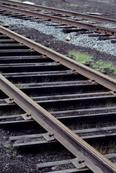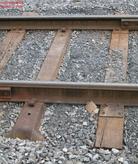
| Home | Open Account | Help | 365 users online |
|
Member Login
Discussion
Media SharingHostingLibrarySite Info |
Nostalgia & History > Steel rail crosstiesDate: 06/16/04 18:55 Steel rail crossties Author: RDG5308 I shot this back in 1983 at Rouses Point, NY on the D&H. This I believe was an engine service track which had crossties made of rail. I didnt get the impression that it was jury-rigged by the precise cut of the rail and the tie plate style. It looked more like something that was bought that way. Im curious if any of you have seen or heard of this anywhere else. The only other reference, Ive seen was a similar style in photos of one of the Bethlehem Steel railroads, the Cornwall RR in Lebanon, PA. I would think this might be more durable in a steam locomotive servicing facility, but I dont recall ever seeing it in any photos.
Always looking to learn more, Charlie  Date: 06/16/04 20:01 Re: Steel rail crossties Author: ConductorAl I believe that they were most widely used in street railways where the support structure for the trackage was to be covered. Reason for that was mostly that once the track was in place and paved over, repairs or adjustments would be practically impossible. Advantages of steel over wood was mostly that it would hold the gauge with no need for adjustment.
Date: 06/16/04 20:58 Re: Steel rail crossties Author: moonliter I came across steel rail crossties in Lake Placid, NY. They seemed to be in an area of the yard where the locomotives were serviced. My first thought was this was a NYC line as I had seen old photoes of NYC trains at the station in Lake Placid. I quickly remembered that the D&H also ran to Lake Placid until 1946. It was the D&H who sold the ex: Saranac and Lake Placid Railroad to the NYC. The steel rail crossties may have also been laid by the D&H prior to 1946.
Gerry, Ottawa ON Date: 06/17/04 08:58 Re: Steel rail crossties Author: GPutz That's very interesting. Thanks for posting the image. I've never heard of steel rails used as cross ties. I took this image yesterday on the Maryland Midland near Keymar, MD. I had never seen steel cross ties before either. About 25% of the cross ties in the connection track between the ex-WM and the ex-PRR lines are like this. I don't know when that connection track was built, probably in the '80s. Gerry
 Date: 06/17/04 10:36 Re: Steel rail crossties Author: Gonut1 Seems to me a logical choice for steam loco ashpan dumping areas, fireproof comes to mind. Certainly of little use in signalled territory. The Yucatan Peninsula railways in Mexico had narrow gauge lines built entirely of steel to overcome insect and moisture problems. It was French made and resembled toy train track. A lot of those railroads were horsedrawn.
Gonut Date: 06/17/04 21:51 Re: Steel rail crossties Author: nitewatchman Steel Cross Ties have been around for over one hundred years. In recent years my company has recovered steel ties supplied to Brazil and South Africa before 1900. Given proper drainage the ties last almost indefinitely in track provided the axle loads are low.
The ties in the first photograph are unknown to me and I would be interested in more information. While they could be made of used rail , their cost would be quite high compared to conventional steel, wood or concrete ties. The ties in the second picture appear to be NARSTCO Steel Ties with a 10mm thickness. These are used in both track and turnouts. The big advantage for steel ties is holding gauge, their capabilities are comparable to concrete with less weight. Steel Tie Turnouts are used in yards, primarily around fueling facilities. A notable exception is the UP yard in Rochelle which has had several steel tie turnouts installed in the last few years. Steel Ties may be used in signaled territory by using insulating rail seat pads and e-clip insulators similar to those used with concrete ties. Rails are typically affixed to the ties using a hook-in Pandrol Shoulder inserted into a punched hole in the tie. Prior to the Hook-In Shoulders, conventional weld-on shoulders were used. This practice has been largely discontinued due to cracking at the toe of the weld. Steel ties excell in areas where conventional ties could become fuel soaked and present a hazard and in severe curves where gauge may tend to spread. Steel Ties may also be handy in tunnels where theri lower height can supply a much need inch or so of clearance. Steel ties also resist derailment damage as well as or perhaps a little better than wood ties and infinity better than concrete ties. While all this sounds okay, steel ties are not without their problems. Firstly, a fully dressed steel tie tends to be more expensive than either a wood or concrete tie. The steel tie is also lighter than a concrete tie which is not always a good thing, for track modulus, weight can be your friend. There are also other problems, in track as the tie pumps slightly it tends to draw up fines and mud into the hollow inside area of the tie. Given time the inside may be found to be completely packed with mud compromising the stability of the tie and making tamping almost impossible. The 1" diameter hole in the top of the tie outside the clip shoulder is an inspection hole to check the inside fill of the tie for the absence of ballast or presence of mud. The ties also tend to be a little slippery in ballast and by must be modified by smashing the ends down to obtain lateral stability. A very significant program was monitored some years back to determine the optimal "smash" for the tie ends. Perhaps the worst problem associated with steel tie is rail seat cracking caused by cyclic fatigue. These cracks may appear in a few years time in high axle load track and it is not repairable. At least one Class I Railroad has completely discontinued use of the ties in track except for service facilities. To my knowledge the only place in the world where steel ties are common in main line track is South Africa. nitewatchman Date: 06/18/04 09:59 Re: Steel rail crossties Author: BobB Wouldn't a steel tie tend to shunt the track, thus affecting the signals? That wouldn't matter in dark territory or on unsignalled sidings or yard tracks, but it would be a problem elsewhere unless the ties were well insulated.
Date: 06/18/04 12:04 Re: Steel rail crossties Author: nitewatchman In the attached photo, notice that the hook-in shoulder carrys an e-clip to clamp the rail in place. An insulated pad is placed under the rail base forming the rail seat and an insulator is located under the toe of the e-clip to insulate between the e-clip and rail base and additionally the side of the rail base from the shoulder.
nitewatchman  Date: 06/18/04 12:37 Re: Steel rail crossties Author: tburzio Hi!
You'd be amazed how easy it is to remove these spring clips. I watched a worker removing the clips at Anaheim by lightly tapping with a sledge hammer swung by gravity as a pendulum. The clips jumped about 5 feet down the tracks. Tony Burzio San Diego, CA Date: 06/05/07 23:11 Re: Steel rail crossties Author: poultrycar This is an old post, but when we "visited" Germany in February of 1945 I was surprised to note that almost all main line railroads used steel ties. I had never seen one in North America at that time. The ties seem to be very durable and looked as though they were there for many years even before 1945.
On VERY recent trips to Germany the steel ties seem to have mostly been replaced with concrete ties. Maybe heavier rails would not fit the older steel ties, but whatever, the switch is to concrete. I did note that there were still a lot of main line steel ties in Switzerland, but they seem to be switching to concrete as well, even the meter gauge lines. |